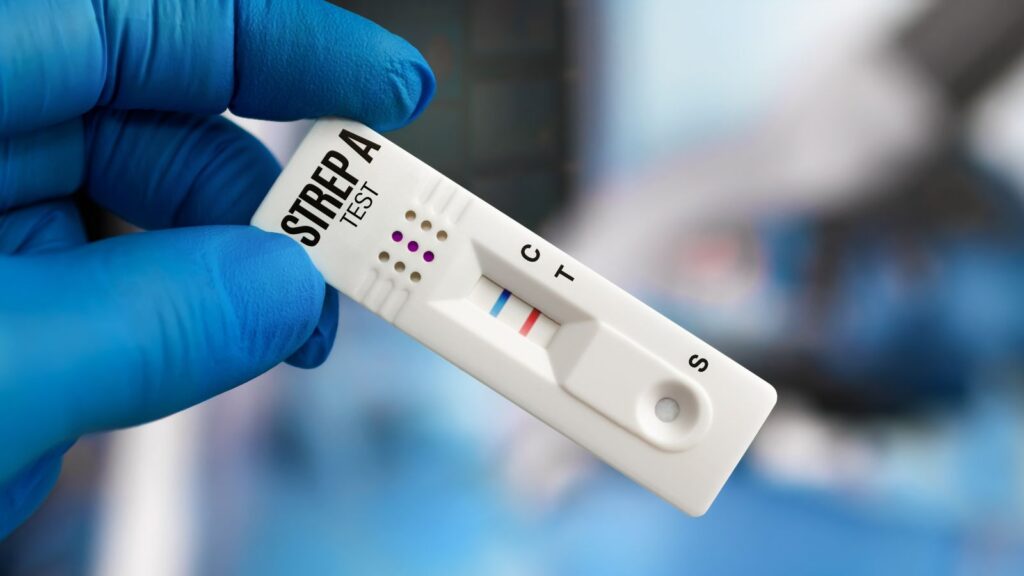Rapid strep and flu testing is useful for anyone showing symptoms like a fever, sore throat, cough, or body aches. These tests can quickly determine if a person has strep throat or the flu, helping guide the right treatment. Anyone with sudden fever, chills, sore throat, or known exposure to strep or flu should consider getting tested to confirm their illness.
The rapid tests work by taking a swab from the throat or nose and provide results in minutes. This quick diagnosis helps stop the spread of infection and allows for faster recovery through proper care. Healthcare providers often recommend these tests when symptoms first appear to avoid unnecessary treatment or delay.
Many health care clinics and urgent care centers offer these tests with no appointment needed, making it easy to get answers and start treatment fast. Knowing when to get tested can reduce discomfort and prevent complications for both individuals and those around them.
Rapid Strep and Flu Testing: Who Should Get It and When?
What Is Rapid Strep and Flu Testing?
Rapid strep and flu tests help quickly identify if a person has strep throat or the flu. These tests work by detecting specific proteins from bacteria or viruses. They are faster than traditional lab tests and are often used in clinics to guide immediate treatment.
Overview of Rapid Diagnostic Tests
Rapid diagnostic tests are designed to deliver fast results, usually within 10 to 30 minutes. They are commonly done by swabbing the throat or nose. The main goal is to identify infections early, so treatment or further action can begin quickly.
These tests focus on detecting antigens, proteins found on the surface of the bacteria or virus causing the illness. Rapid tests are widely available and used for infections like strep throat, influenza, and whooping cough. They help reduce the spread of illness by confirming the cause of symptoms promptly.
How Tests Work for Strep Throat and Influenza
Rapid tests use a swab sample from the throat (for strep) or nose (for flu). The sample is tested for antigens specific to Streptococcus pyogenes (strep throat bacteria) or influenza viruses.
If antigens are present, the test shows a positive result. A positive rapid strep test usually leads to antibiotic treatment. For the flu, antivirals may be considered depending on the case.
These tests are simple, often performed at the point of care, and do not require sending samples to a lab. In some cases, additional tests may help rule out infections like respiratory syncytial virus or Haemophilus influenzae type illnesses.
Comparing Rapid Versus Traditional Testing Methods
Traditional tests, like throat cultures for strep or lab-based flu tests, take longer of up to 24-48 hours for results. They are more sensitive, meaning they can detect infections even when bacterial or viral levels are low.
Rapid tests have about 90-95% accuracy but can sometimes give false negatives. This may require follow-up with a traditional test if symptoms persist despite a negative rapid result.
| Feature | Rapid Test | Traditional Test |
|---|---|---|
| Time to Results | 10–30 minutes | 1–2 days |
| Accuracy | 90–95% | Higher (more sensitive) |
| Sample Type | Throat or nasal swab | Throat culture or lab analysis |
| Use Case | Quick diagnosis, treatment | Confirmation, detailed testing |
Who Should Get Rapid Strep and Flu Testing?
Rapid strep and flu testing are important tools for diagnosing infections quickly. People most likely to benefit from testing include those in certain risk groups, those showing key symptoms, and those working with vulnerable populations. Testing helps guide treatment and reduces the spread of illness.
High-Risk Populations
People with weakened immune systems, chronic illnesses, or other health conditions should consider testing. These groups are more likely to develop complications from the flu or strep infections.
Children and adults aged 50 years or older are also at higher risk because infections can be more severe or harder to diagnose in these age groups. Pregnant women may need testing to protect their health and that of their unborn baby.
Patients in crowded environments like schools or nursing homes should get tested quickly if symptoms appear to prevent outbreaks. Health care providers often recommend testing to minimize the spread of contagious bacterial infection.
Individuals With Specific Symptoms
Rapid tests are recommended for people showing symptoms like sore throat, fever, cough, body aches, and headache. If a sore throat is severe and worsens when swallowing, or if fever and headache occur quickly, testing is advised to check for strep infection or scarlet fever.
Flu symptoms such as sudden fever, muscle pain, chills, and fatigue are triggers for testing. Flu vaccinations can help protect against infection, but testing ensures appropriate treatment if symptoms develop despite vaccination.
People experiencing these symptoms should seek testing, especially if they have had recent contact with others known to be sick.
Healthcare Workers and Caregivers
Healthcare workers who have symptoms of flu or strep should get rapid testing to avoid spreading infections to patients.
Caregivers of young children, elderly adults, or people with weakened immune systems should also get tested when ill. This action helps protect those they care for from catching these infections.
Rapid testing in these groups supports workplace safety and public health. It allows quick decisions on work restrictions or treatment to prevent outbreaks.
Testing helps maintain healthy environments in hospitals, clinics, and homes where close contact with vulnerable people is common.
When Is the Right Time to Test?
Testing for strep throat or the flu is most effective when timed according to symptoms, the time of year, and recent contact with infected people. Testing too early or too late can lead to inaccurate results. Knowing the right timing helps ensure proper diagnosis and treatment.
Timing Based on Symptom Onset
Testing is most effective when done within the first few days of illness. It’s generally recommended to perform rapid strep and flu testing about 1–3 days after symptoms begin, as testing too early can lead to false negatives if the bacteria or virus isn’t yet detectable. For strep throat, a negative rapid strep test followed by persistent symptoms may require a throat culture, which is more sensitive and takes longer.
For the flu, testing within the first 3–4 days of symptoms provides the most accurate results, since virus levels in the nose and throat decrease over time. Primary care providers may also assess overlapping conditions or COVID-19 vaccine response side effects when similar symptoms appear.
Seasonal Considerations
Testing is more common during peak flu and strep seasons. Flu tests are especially important in the fall and winter when cases rise. During flu season, a positive rapid flu test is more likely to be accurate because the virus is widespread.
Strep throat testing increases in late winter and early spring when bacterial infections spread more easily. Outside these seasons, symptoms might be caused by other viruses, so testing may be less urgent or require confirmation.
Recent Exposure to Infected Individuals
People exposed to someone diagnosed with strep throat or the flu should monitor for symptoms before testing. Testing immediately after exposure without symptoms might not detect infection.
If symptoms appear after exposure, testing should be done quickly to confirm infection. Early diagnosis helps avoid spreading illness and enables timely treatment. Testing close contacts is not usually recommended unless symptoms arise.
Benefits and Considerations for Rapid Testing
Rapid strep and flu tests deliver results quickly, aiding in faster treatment decisions. They help identify infections early but come with some accuracy limits. These tests also play an important role in managing public health during illness outbreaks.
Advantages of Early Diagnosis
Rapid tests provide results within minutes, often during a single doctor’s visit. This speeds up diagnosis, allowing healthcare providers to start the right treatment without delay.
Early diagnosis helps reduce symptoms faster and prevents complications. For example, identifying strep throat quickly means antibiotics can be given promptly, lowering the risk of severe illness.
Patients also benefit from peace of mind when they get quick answers. It reduces unnecessary use of antibiotics or other medications when the test is negative.
Limitations and Accuracy
Rapid tests are generally accurate but not perfect. The accuracy depends on the test type and how well it is performed.
False negatives can occur, meaning an infection is missed. This may require a follow-up test, like a throat culture for strep, to confirm the results.
False positives happen less often, but they can lead to unnecessary treatments. Understanding these limits helps doctors avoid mistakes in patient care.
Environmental conditions and sample quality affect test results, too. Proper training and testing environment improve reliability.
Public Health Implications
Rapid strep and flu testing play a crucial role in controlling the spread of infections during flu and cold seasons by identifying cases early. Quick diagnosis allows patients to isolate sooner, reducing virus transmission in schools, workplaces, and communities.
Health providers can also track outbreaks more efficiently and respond with public health measures such as flu vaccinations, awareness campaigns, and preventive care through trusted primary care providers. This early intervention helps protect vulnerable populations and reduce the overall impact of seasonal illnesses.
Widespread use of rapid testing supports better resource management in health care, ensuring treatment focuses on those most in need. By targeting high-risk patients first, providers can limit the spread of disease and prevent unnecessary use of medical services.
It also reinforces confidence in vaccines like the TDaP vaccine and ongoing vaccine protection initiatives, which promote immunity for pregnant women, children, and adults seeking preventive health options. These efforts work hand-in-hand with rapid testing to strengthen community health and safety.
Our Urgent Care Walk-In Clinics in Omaha, Bennington, West Omaha, Rockbrook, Crossroads & Bellevue, NE
Our staff works to provide prompt, personal, and professional care for all of our patients. We strive to provide the attention patients need in as quick a time as possible. Urgent Care Clinics in Omaha & Bellevue, Nebraska, has three locations in the Omaha metropolitan area. Our three walk-in clinics are:
- Rockbrook Urgent Care
- Crossroads Urgent Care
- Bellevue Urgent Care
- West Omaha Urgent Care
- Bennington Urgent Care
Disclaimer
The information contained on this webpage is for educational purposes as well as to provide general information and a general understanding of the pertinent medical issue, only, not to provide a specific diagnosis. This information is not intended to be a substitute for professional medical advice. By using this blog/website, you understand there is no doctor-patient relationship between you and the blog/website publisher. The information included on this site should not be used as a substitute for medical advice from a licensed medical professional in your state. Neither Urgent Care Network, its subsidiaries, affiliates, assignees, or successors in interest, nor any other party assumes liability for loss or damage due to reliance on the content of this blog/website. If you are experiencing a severe medical issue, you should seek emergency assistance immediately.







